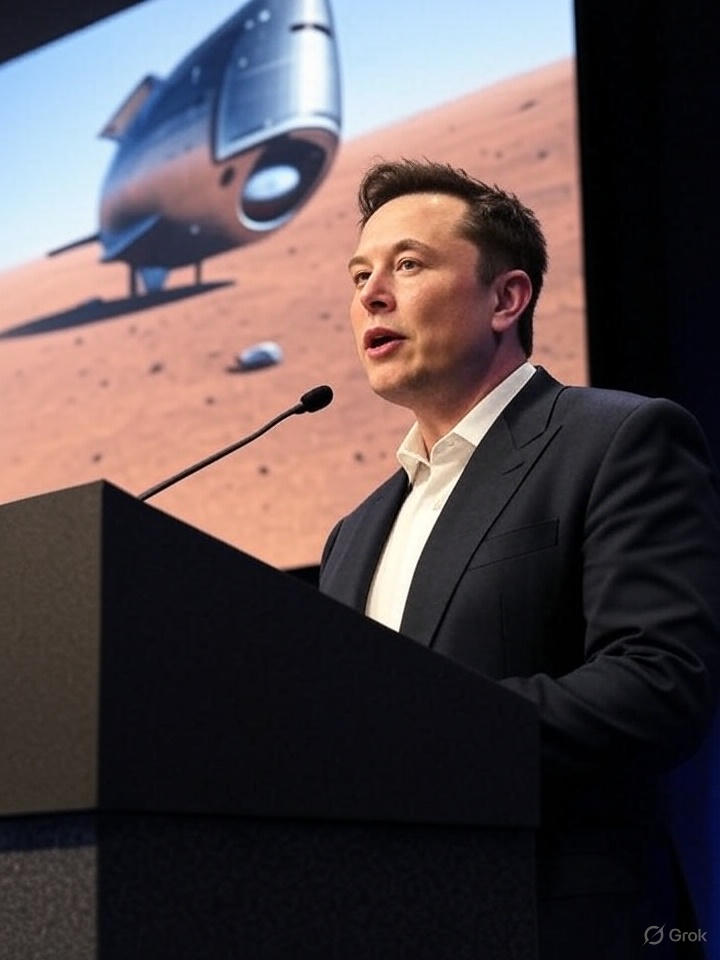In late May 2025, Elon Musk announced that SpaceX is targeting a first uncrewed Starship mission to Mars by the end of 2026, coinciding with the next Earth Mars transfer window. He estimated roughly a 50% chance of hitting this timeline, contingent on key milestones including a successful orbital refuelling capability.(Al Jazeera)
Ambitious Timeline & Technical Challenges
SpaceX plans to launch five Starship upper stages to Mars during the late 2026 window, each aiming to land on the Martian surface to gather critical entry and landing performance data. If these landings succeed, crewed missions could begin in the 2029, 2031 window.(Wikipedia)
However, Starship has not yet achieved Earth orbit a prerequisite for Mars readiness. Recent test flights (Nos. 7, 8, and 9) resulted in loss of the spacecraft after launch due to various failures, underlining the program’s fragility. A June 2025 explosion of Starship 36 during static fire testing renewed doubts about whether the timeline is realistic.(Information Age, Wikipedia, The Economic Times, Globedge).
Among the most formidable engineering hurdles is in orbit refuelling a feat never achieved at this scale, requiring docking multiple large spacecraft and cryogenic propellant transfer. Musk identified this as Starship’s “next big challenge.”(Wikipedia)
Strategic Vision & Payload Plans
Musk has framed the Mars mission as more than a technical milestone it’s part of a broader vision to make humanity multi planetary and safeguard civilization’s long term survival. He envisions producing up to 1,000 Starships per year, surpassing Boeing and Airbus combined output.(barrons.com)
The first Mars mission is expected to carry a simulated crew of Tesla built Optimus humanoid robots, tasked with arriving ahead of human passengers to scout landing sites. The hope is that successful robotic missions by 2026 will pave the way for crewed landings by 2029 or 2031.(Al Jazeera)
Skepticism & Expert Concerns
Analysts remain skeptical about the 2026 goal, citing the steep technical demands and SpaceX’s turbulent testing history. Some suggest that a plausible Mars launch might arrive in 2028 or later if more development time is needed.(Reddit, Medium, Information Age)
One commentator emphasized that Starship has still not reached orbit, and repeated failures signal that the company may not be effectively learning from mistakes. Still, Musk and his team view failures as data driven progress rather than setbacks.(Medium)
Program Roadmap & Scaling Ambition
- 2026 window: Attempt up to five unmanned Starship landers on Mars to assess critical transition and landing technologies.(Wikipedia)
- 2028,2029 window: Scale to approximately 20 missions, refining logistics and surface operations.
- 2030,2031 window: Launch 100 missions, building toward sustained payload delivery and infrastructure.
- By 2033: Target up to 500 mission launches per window, laying groundwork for long term colonization.(Wikipedia, Wikipedia)

Key Focus Areas for Success
- Orbital Refuelling must be mastered early in 2026 to enable Mars trajectories.
- Reusable Launch Cadence achieving regular, rapid Starship launches with minimal refurbishment.
- Heat Shield & EDL Robustness surviving Mars entry and descent safely at high speeds.
- Data Gathering Landers initial bot crewed Starships must collect entry and terrain data for future missions.
Summary
Elon Musk’s new update places SpaceX’s first uncrewed Starship Mars mission in late 2026, contingent on breakthroughs in orbital refuelling and launch reliability. While Musk cites a 50% probability of meeting the deadline, technical complexity and recent test failures leave many experts doubtful. SpaceX continues its development through iterative flight testing and plans an increasingly ambitious Mars mission cadence across the 2028, 2030, and 2033 windows. If successful, these missions could lay the foundation for crewed voyages by 2029 – 2031 marking a bold step toward humanity’s multi planet future.(Reddit)

